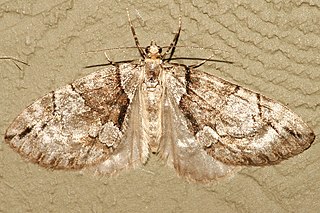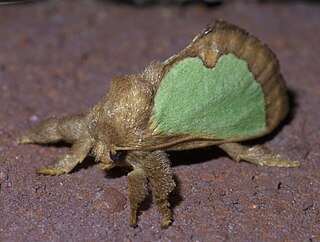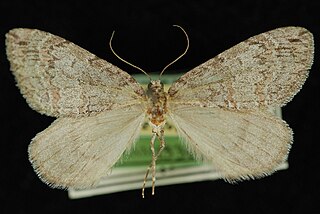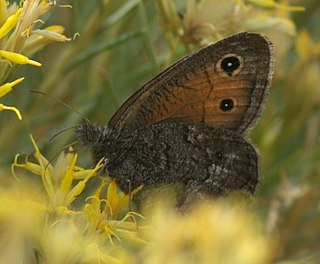
Euphilotes is a genus of butterflies in the family Lycaenidae, which consists of a number of species found in western North America. Some of the species are endangered, such as the Smith's blue, Euphilotes enoptes smithi.

Euphilotes battoides, the square-spotted blue or buckwheat blue, is a species of butterfly of the family Lycaenidae. It is found in western North America from Washington south to Baja California Norte and then west to southern Colorado and New Mexico.

Euphilotes enoptes, the dotted blue, is a species of blue (Polyommatinae) butterfly in the family Lycaenidae. It is found in North America.

Hydriomena exculpata is a species of moth in the family Geometridae first described by William Barnes and James Halliday McDunnough in 1917. It is found in North America.
Euphilotes centralis, the central blue, is a butterfly in the family Lycaenidae. It was first described by William Barnes and James Halliday McDunnough in 1917. It is found in North America.

Euclea is a genus of moths in the family Limacodidae. The genus was erected by Jacob Hübner in 1819. There are at least 40 described species in Euclea.
Glena interpunctata is a species of moth in the family Geometridae first described by William Barnes and James Halliday McDunnough in 1917. It is found in North America.

Nemoria darwiniata, the Columbian emerald, is a species of emerald moth in the family Geometridae. It was first described by Harrison Gray Dyar Jr. in 1904 and it is found in North America.

Hydriomena expurgata is a species of moth in the family Geometridae first described by William Barnes and James Halliday McDunnough in 1918. It is found in North America.
Destutia excelsa is a species of moth in the family Geometridae first described by Strecker in 1878. It is found in North America.
Carphoides inconspicuaria is a species of moth in the family Geometridae first described by William Barnes and James Halliday McDunnough in 1916. It is found in North America.

Hydriomena marinata is a species of moth in the family Geometridae first described by William Barnes and James Halliday McDunnough in 1917. It is found in North America.
Mericisca perpictaria is a species of moth in the family Geometridae first described by William Barnes and James Halliday McDunnough in 1916. It is found in North America.

Apodemia mejicanus, the Mexican metalmark or Sonoran metalmark, is a species of butterfly in the family Riodinidae. It was first described by Hans Hermann Behr in 1865. It is found in North America.
Digrammia cinereola is a species of moth in the family Geometridae first described by George Duryea Hulst in 1896. It is found in North America.

Cercyonis meadii, or Mead's wood nymph, is a species of brush-footed butterfly in the family Nymphalidae. It was first described by William Henry Edwards in 1872 and it is found in North America.

Homorthodes hanhami is a species of cutworm or dart moth in the family Noctuidae first described by William Barnes and James Halliday McDunnough in 1911. It is found in North America.
Euphilotes spaldingi, or Spalding's blue, is a butterfly of the family Lycaenidae. The species was first described by William Barnes and James Halliday McDunnough in 1917. It is found in North America.

Aethalura intertexta, the four-barred gray or smoky carpet moth, is a moth in the family Geometridae. The species was first described by Francis Walker in 1860. It is found in North America.

Tallula is a genus of pyralid moths in the family Pyralidae. There are about 11 described species in Tallula.













